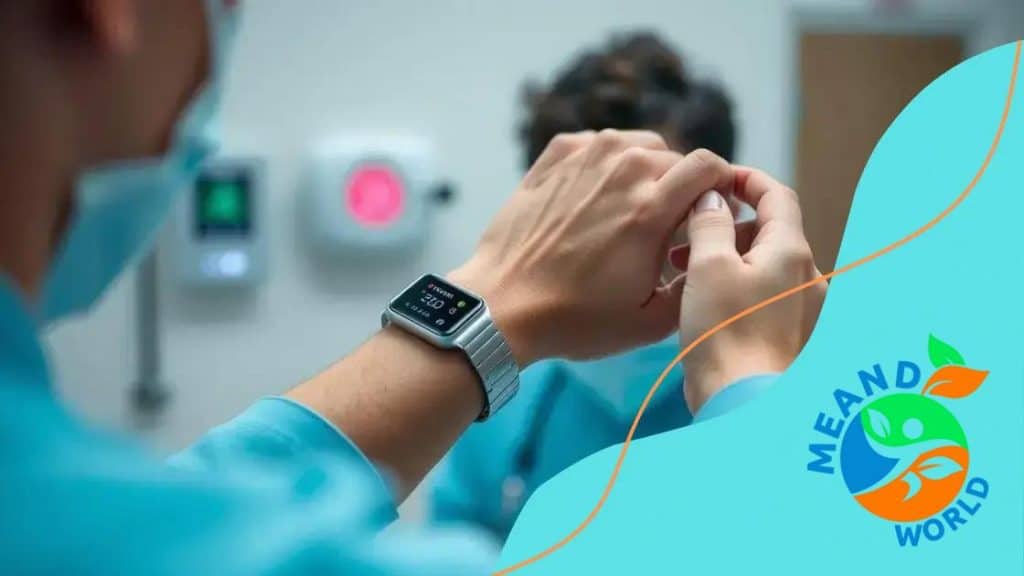How wearable technology is improving healthcare monitoring

Anúncios
Wearable technology is improving healthcare monitoring by providing real-time health data, enabling early detection of issues, and enhancing patient engagement in managing their health.
How wearable technology is improving healthcare monitoring is reshaping the landscape of health management. These devices offer real-time insights into patient health, transforming both patient care and clinical efficiency. Ready to uncover their benefits?
Anúncios
Understanding wearable technology in healthcare
Wearable technology is increasingly becoming integral in healthcare. These devices do more than just look stylish; they are designed to track health metrics and provide valuable insights to both users and healthcare providers.
Anúncios
When we talk about wearable technology in healthcare, it’s essential to understand how these innovations work. The goal is to enhance patient monitoring and improve outcomes.
Types of Wearable Technology
There are various types of wearables used in healthcare. They include:
- Fitness trackers that record daily activity levels and calorie burn.
- Heart rate monitors that provide real-time feedback on cardiovascular health.
- Smartwatches equipped with health apps capable of monitoring multiple parameters.
- Medical devices like glucose monitors for patients with diabetes.
Each of these devices serves a specific purpose, providing users with data that can help manage their health more effectively.
Integration with smartphones and health apps makes these wearables even more powerful. Users can easily track their progress and access historical data. This accessibility promotes personal responsibility in health management.
Benefits of Wearable Technology
The advantages of wearable technology in healthcare are numerous. Not only do they help in monitoring health in real-time, but they also allow for early detection of potential health issues.
- Continuous data collection enables personalized health insights.
- They facilitate remote monitoring, reducing hospital visits.
- Wearable devices promote proactive health management.
Additionally, they can provide alerts and reminders, helping individuals stay on top of their health routines. By empowering patients with data, wearable technology encourages them to take an active role in their health journey.
Key benefits of wearable devices
Wearable devices offer numerous advantages that significantly enhance healthcare monitoring. These innovations provide users with tools to actively track their health and well-being, making it easier to manage everyday activities.
The benefits of these devices are profound. For example, they facilitate real-time health tracking, which allows users to monitor their vital signs continuously. This ability can lead to quicker interventions in case of anomalies. Imagine being alerted immediately to an unusual heart rate or blood sugar level!
Advantages of Wearable Devices
Several key benefits make wearable devices appealing to users:
- Enhanced health management through continuous monitoring.
- Early detection of potential health issues.
- Increased patient engagement and accountability.
- Data collection for personalized healthcare plans.
Each of these points highlights how wearables not only track data but also foster a healthier lifestyle. By offering actionable insights, these devices can empower users to make informed decisions about their health.
Moreover, wearables can easily integrate with smartphones and health apps, allowing users to visualize their data over time. This integration promotes informed discussions with healthcare providers. Consequently, patients can bring valuable data to appointments, leading to more personalized care strategies.
Promoting Preventive Care
Preventive care is one of the most significant advantages that wearable devices provide. By monitoring health metrics, users can identify trends and make lifestyle adjustments promptly. For instance, regular tracking of physical activity can encourage increased movement, while monitoring sleep patterns can lead to improved rest. In this way, wearables pave the way for a healthier future by promoting proactive health management.
Integration of wearables with healthcare systems

The integration of wearable devices with healthcare systems is transforming how we approach patient care. By seamlessly connecting data collected from wearables to healthcare providers, we can enhance the overall quality of treatment.
These devices collect important health metrics such as heart rate, activity levels, and sleep patterns. When this data is integrated into electronic health records (EHRs), it allows healthcare professionals to have a comprehensive view of a patient’s health. This holistic perspective facilitates better decision-making and personalized treatment plans.
Benefits of Integration
There are several advantages to integrating wearable technology with healthcare systems:
- Improved accuracy in diagnosing health conditions.
- Timely interventions based on real-time data.
- Enhanced collaboration among care teams.
- More engaged patients who are active participants in their health management.
The enhanced communication between wearable devices and healthcare platforms means that medical staff can receive alerts about patient health issues immediately. For example, if a heart rate monitor indicates an abnormal rhythm, doctors can intervene quickly. This quick response can save lives.
Furthermore, integration enables remote patient monitoring, allowing physicians to track patients’ health from afar. This is especially beneficial for those managing chronic conditions. Patients can feel more secure knowing their health is being monitored continuously, without the need for frequent visits to the clinic.
Challenges in Integration
Despite the clear benefits, challenges remain in the integration process. Issues such as data privacy and security must be addressed to protect sensitive patient information. Additionally, interoperability among various technologies can be a challenge. Ensuring that different devices communicate effectively is vital for successful integration.
Overcoming these hurdles is essential for maximizing the potential of wearable technology in healthcare. Addressing concerns ensures that both patients and providers can benefit from advancements without compromising safety.
Real-world applications of wearable tech
Wearable technology has numerous real-world applications that showcase its impact on healthcare monitoring. By providing practical solutions to everyday health challenges, these devices have revolutionized how individuals manage their health.
One prominent application is in fitness and activity tracking. Wearables like fitness bands and smartwatches can monitor steps taken, calories burned, and even heart rate throughout the day. This constant monitoring encourages users to stay active and meet their fitness goals. Imagine receiving an alert to take a walk after sitting too long!
Examples of Real-World Applications
Here are some key examples of how wearable technology is applied in the real world:
- Chronic disease management: Devices help monitor conditions like diabetes by tracking blood glucose levels in real-time.
- Remote patient monitoring: Doctors can track heart patients’ vital signs from home, reducing the need for in-person visits.
- Mental health monitoring: Wearables track indicators of stress and sleep patterns, aiding in early intervention for mental health issues.
- Telemedicine integration: Wearable devices provide data that can be analyzed during virtual consultations, improving patient-provider communication.
These applications not only improve patient outcomes but also enhance the overall healthcare experience. By using wearables, patients become more engaged in their health management, fostering a sense of ownership over their well-being.
Furthermore, wearables are being integrated into health programs. Hospitals and clinics are utilizing these devices to encourage patients to adopt healthy behaviors and monitor vital signs post-surgery. Such programs have shown a reduction in readmission rates and better adherence to treatment plans. As technology advances, the potential applications of wearables within healthcare will continue to expand.
Innovations in Wearables
Innovations in wearable technology also promise exciting developments. Future devices may incorporate advanced sensors, allowing for even more precise health tracking. Imagine wearables that provide early detection of conditions like arrhythmias or sleep apnea, potentially saving lives through timely intervention.
Challenges in implementing wearable health technology
Implementing wearable health technology brings numerous challenges that need careful consideration. While these devices offer amazing benefits for health monitoring, their adoption is not without hurdles.
The first challenge is ensuring data privacy and security. Wearable devices collect sensitive health information, and if this data is not adequately protected, it could lead to serious privacy breaches. Patients must trust that their personal information is secure before they will fully embrace these technologies.
Common Challenges in Implementation
Some of the common issues faced when integrating wearable health technology include:
- Interoperability: Different devices must communicate smoothly with existing healthcare systems.
- User engagement: Encouraging patients to consistently use the devices can be challenging; many may forget or neglect to wear them.
- High costs: The price of advanced wearables can be a barrier for some users, limiting accessibility.
- Regulatory hurdles: Gaining regulatory approval can slow down the introduction of new health-tech devices into the market.
Addressing these challenges is vital for the successful integration of wearable technology in healthcare settings. For example, manufacturers and developers must work on creating devices that can easily connect to various health systems. Moreover, efforts should be made to increase awareness and education concerning the benefits of these devices to improve user engagement.
Additionally, continuous feedback from users can help companies improve their products over time. Gathering insights from healthcare providers and patients can lead to improvements in design and functionality, making the devices more user-friendly and effective.
Tackling Data Privacy Issues
To ensure data security, healthcare organizations must enforce strict protocols regarding how data is collected, stored, and shared. They should also provide clear information to users about what data is being used and reassure them of its security. This transparency can foster greater acceptance and attract more patients to embrace wearable technology for health monitoring.
FAQ – Frequently Asked Questions about Wearable Technology in Healthcare
What are the main benefits of wearable technology in healthcare?
Wearable technology provides real-time health monitoring, early detection of health issues, and promotes patient engagement.
How do wearables integrate with existing healthcare systems?
Wearables can connect to healthcare systems, allowing data to be easily shared and analyzed by healthcare providers.
What challenges are associated with implementing wearable health technology?
Challenges include data privacy and security, ensuring user engagement, and achieving interoperability with different devices.
Can wearable devices improve chronic disease management?
Yes, wearables help monitor vital signs and health metrics, enabling better management of chronic conditions like diabetes and hypertension.





